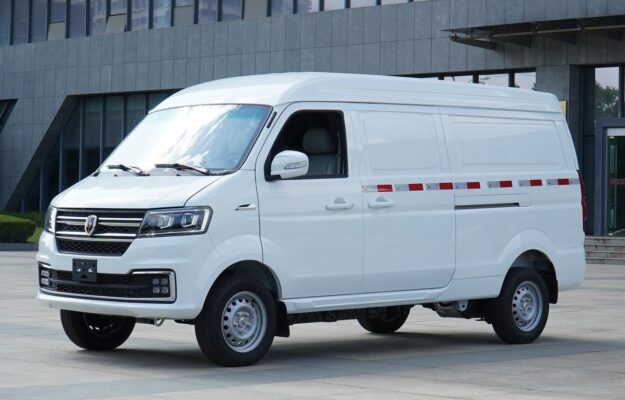A battery – automjeti elektrik, often simply referred to as a pure automjeti elektrik or EV (Electric Vehicle), is a type of automobile that is solely powered by electricity. Unlike traditional fuel – powered vehicles, battery – electric vehicles do not rely on internal combustion engines to drive the vehicle. Instead, the electrical energy stored in the battery pack powers the electric motor, which in turn propels the vehicle forward. By converting electrical energy into mechanical energy without emitting exhaust gases, battery – automjeti elektriks are regarded as an environmentally friendly and efficient means of transportation.
What Are the Advantages of Battery – Electric Vehicles?
Bateri – electric vehicles offer the following advantages:
1. Zero – Emission
Bateri – electric vehicles produce no emissions. Since they do not use fuel, they do not generate exhaust pollution. This makes them environmentally friendly and contributes to improving air quality and reducing greenhouse gas emissions. In urban areas, where air pollution is a significant concern, the widespread adoption of battery – electric vehicles can have a profound impact. For example, in cities like Beijing and Los Angeles, which often suffer from smog, replacing a large number of traditional fuel – powered vehicles with battery – electric vehicles can effectively reduce the concentration of pollutants such as particulate matter (PM2.5), sulfur dioxide, and nitrogen oxides in the air. This not only benefits the health of urban residents but also helps to mitigate the effects of climate change.
2. Lower Energy Costs
The energy costs of battery – electric vehicles are relatively low. Compared with fuel – powered vehicles, battery – electric vehicles have a lower cost per kilometer of travel. The price of electricity is relatively stable, and charging facilities are becoming increasingly widespread. In many regions, the cost of electricity for charging an electric vehicle is significantly lower than the cost of gasoline or diesel for fuel – powered vehicles. For instance, in some European countries, the average cost of charging an electric vehicle for a 100 – kilometer journey is only a fraction of the cost of refueling a similar – sized fuel – powered vehicle. Për më tepër, with the development of smart grid technology, electric vehicle owners can take advantage of off – peak electricity prices, further reducing their energy costs.
3. Lower Maintenance Costs
Bateri – electric vehicles have lower maintenance costs. Their structure is relatively simple, lacking complex components such as engines. As a result, maintenance costs are reduced, and there is no need for regular oil and filter replacements. Without an internal combustion engine, battery – electric vehicles do not require frequent oil changes, spark plug replacements, or engine tune – ups. The absence of a complex transmission system also means fewer moving parts that can wear out over time. For example, the electric motors in battery – electric vehicles have a long service life and require minimal maintenance. This not only saves vehicle owners money on maintenance but also reduces the time spent in the repair shop.
4. Unique Driving Experience
Bateri – electric vehicles offer a unique driving experience. They provide a smooth and quiet ride. The instant torque output of electric motors allows battery – electric vehicles to accelerate more rapidly, giving drivers a more comfortable driving experience. The smooth acceleration of electric vehicles is due to the nature of electric motors, which can deliver maximum torque from a standstill. This is in contrast to traditional internal combustion engines, which require time to build up power. In addition, the absence of engine noise and the smooth operation of electric motors create a quiet and peaceful driving environment. This is particularly appealing to drivers who value a quiet and comfortable driving experience, such as those who commute in urban areas or drive luxury vehicles.
What Are the Disadvantages of Battery – Electric Vehicles?
However, battery – electric vehicles also have some disadvantages:
1. Limited Driving Range
The driving range of battery – electric vehicles is relatively limited. Current battery technology restricts the driving range of battery – automjetet elektrike. Compared with traditional fuel – powered vehicles, they need to be charged more frequently during long – distance travel. Although significant progress has been made in battery technology, the energy density of current batteries is still relatively low. This means that for a battery – electric vehicle to travel a long distance, it needs to carry a large and heavy battery pack. For example, while a mid – sized gasoline – powered sedan can typically travel 500 – 800 kilometers on a full tank of fuel, a similar – sized battery – electric vehicle may have a driving range of only 300 – 600 kilometers on a full charge. This limited driving range can cause range anxiety for drivers, especially those who frequently travel long distances.
2. Long Charging Time
Charging a battery – electric vehicle takes a relatively long time. Compared with refueling a fuel – powered vehicle, the time required to charge an electric vehicle is much longer. The construction of charging facilities and the improvement of charging speed remain one of the challenges in the development of battery – automjetet elektrike. A full charge of a battery – electric vehicle using a standard household charger can take 8 – 12 hours. Even with fast – charging technology, it can still take 30 minutes to several hours to charge the vehicle to a sufficient level for long – distance travel. This long charging time is a major inconvenience for drivers, especially those who are in a hurry or need to make multiple stops during a long journey.
3. Inadequate Charging Infrastructure
The charging infrastructure for battery – electric vehicles is relatively underdeveloped. The number and distribution of charging stations are still unable to meet the needs of large – scale popularization of battery – automjetet elektrike. The construction of charging facilities urgently needs to be strengthened. In many areas, especially in rural regions and some older urban neighborhoods, the lack of charging stations makes it difficult for electric vehicle owners to charge their vehicles. Even in some urban areas where charging stations are present, issues such as long waiting times, high charging fees, and incompatible charging standards can also discourage potential buyers. For example, in some small towns, there may be only one or two public charging stations, which are often occupied, forcing electric vehicle owners to travel long distances to find an available charging point.
4. Challenges in Battery Manufacturing and Recycling
Battery manufacturing and recycling still face challenges. The production process of batteries has a certain environmental impact, and the recycling and reuse of batteries also need to be addressed. The production of lithium – ion batteries, which are commonly used in battery – automjetet elektrike, requires the extraction of raw materials such as lithium, cobalt, and nickel. The extraction and processing of these raw materials can cause environmental problems such as water pollution and habitat destruction. In addition, when batteries reach the end of their life cycle, proper recycling is crucial to prevent environmental pollution and recover valuable resources. However, the current battery recycling technology is still in the development stage, and there is a lack of a comprehensive and efficient recycling system.
What Is the Development Prospect of Battery – Electric Vehicles?
The development prospect of battery – electric vehicles is very promising:
1. Growing Global Concern for the Environment
With the increasing global attention to environmental issues, battery – automjetet elektrike, as a zero – emission means of transportation, have great potential. Governments around the world are introducing electric vehicle subsidy policies and emission reduction targets to promote the development of the battery – electric vehicle industry. For example, in China, the government has provided generous subsidies to electric vehicle manufacturers and consumers, which has significantly increased the sales volume of battery – automjetet elektrike. In the European Union, strict emission reduction targets have been set, forcing automakers to invest more in the development of electric vehicles. These policies not only encourage the production and consumption of battery – electric vehicles but also drive the development of related industries such as battery manufacturing and charging infrastructure construction.
2. Continuous Advancement in Battery Technology
The continuous progress of battery technology helps to improve the driving range and charging efficiency of battery – automjetet elektrike, further meeting the needs of consumers. Scientists and researchers are constantly exploring new battery chemistries and manufacturing techniques to increase the energy density of batteries, reduce charging time, and improve battery lifespan. For example, solid – state batteries, which are still in the research and development stage, have the potential to significantly increase the energy density of batteries, allowing battery – electric vehicles to have a longer driving range. In addition, fast – charging technology is also advancing rapidly, with some new charging technologies claiming to be able to charge an electric vehicle to 80% in less than 15 minutes.
3. Gradual Improvement of Charging Infrastructure
The gradual improvement of the charging infrastructure provides convenience for the popularization of battery – automjetet elektrike. More and more charging stations are being built, and charging points can be easily found in public places, commercial areas, and residential areas. In many large cities, charging stations are being installed in parking lots, shopping malls, and gas stations. Some countries are also promoting the construction of fast – charging networks along major highways, which greatly improves the long – distance travel convenience of battery – automjetet elektrike. For example, in Norway, which has one of the highest penetration rates of electric vehicles in the world, the charging infrastructure is very well – developed, with charging stations available in almost every corner of the country.
4. Intensifying Market Competition
The competition in the battery – electric vehicle market is intensifying, making the prices of battery – electric vehicles more reasonable, and more consumers can afford them. As more and more automakers enter the electric vehicle market, competition for market share has become fierce. This competition has led to price cuts, improved product quality, and the introduction of more innovative features. For example, Tesla, which was one of the early entrants in the electric vehicle market, has been facing increasing competition from traditional automakers such as Volkswagen, Toyota, and Hyundai. These companies are launching a series of competitive electric vehicle models at more affordable prices, which has made electric vehicles more accessible to the general public.
Summarize the Characteristics and Development Prospects of Battery – Electric Vehicles
Bateri – electric vehicles are a means of transportation that rely entirely on electricity for power. They have the advantages of zero – emission, low energy costs, and low maintenance costs. Although problems such as limited driving range and inadequate charging infrastructure still exist, with the advancement of technology and the support of policies, the development prospect of battery – electric vehicles is very broad. As part of sustainable transportation, battery – electric vehicles will play a more important role in the future, promoting the realization of low – carbon travel.
The Impact of Battery – Electric Vehicles on the Energy Industry
The rise of battery – electric vehicles has a profound impact on the energy industry. Së pari, it drives the transformation of the power generation structure. With the increasing demand for electricity for charging, power companies need to adjust their power generation strategies. There is a growing trend towards increasing the proportion of renewable energy generation, such as solar, wind, and hydro power. This is because using renewable energy to charge electric vehicles can further reduce carbon emissions and achieve a more sustainable energy future. For example, in some regions with abundant solar resources, power companies are building large – scale solar power plants specifically to supply electricity for electric vehicle charging stations.
Së dyti, the development of battery – electric vehicles also promotes the development of energy storage technology. The batteries in electric vehicles can be used as a distributed energy storage resource. Through vehicle – to – grid (V2G) technology, electric vehicles can feed electricity back to the grid during periods of low demand, helping to balance the power grid load. This not only improves the utilization efficiency of the power grid but also reduces the need for large – scale energy storage facilities. For instance, in some smart grid demonstration projects, electric vehicle owners can participate in the V2G program and earn income by providing electricity to the grid when the electricity price is high.
The Role of Battery – Electric Vehicles in Urban Planning
Bateri – electric vehicles also have a significant impact on urban planning. In terms of transportation infrastructure, the construction of charging stations needs to be integrated into urban planning. Urban planners need to consider the distribution of charging stations in different areas, such as residential areas, commercial areas, and transportation hubs. This requires coordination among different departments, including urban planning, energy, and transportation departments. For example, in some new urban development projects, charging stations are planned and built in advance in residential communities, ensuring that electric vehicle owners can charge their vehicles conveniently at home.
In addition, battery – electric vehicles can also change the layout of urban transportation. With the development of shared – mobility services based on electric vehicles, such as electric vehicle – sharing and ride – hailing services, the demand for private car ownership may decrease. This can lead to a reduction in the number of parking spaces required in urban areas, and the freed – up land can be used for other purposes, such as green space construction or the development of public facilities.
 The Global Market Outlook for Battery – Electric Vehicles
The Global Market Outlook for Battery – Electric Vehicles
In the global market, the penetration rate of battery – electric vehicles varies significantly among different regions. In developed countries such as Norway, the Netherlands, and Sweden, the penetration rate of electric vehicles is relatively high. These countries have implemented a series of policies to encourage the use of electric vehicles, including generous subsidies, preferential parking policies, and the construction of a well – developed charging infrastructure. In contrast, in some developing countries, the penetration rate of electric vehicles is still relatively low. However, with the increasing awareness of environmental protection and the support of the government, the market potential for electric vehicles in these countries is huge.
The global market for battery – electric vehicles is expected to continue to grow in the coming years. According to market research institutions, the global sales volume of electric vehicles is expected to reach tens of millions in the next decade. This growth will be driven by factors such as the continuous improvement of battery technology, the expansion of the charging infrastructure, and the increasing demand for sustainable transportation.
The Future Technological Trends of Battery – Electric Vehicles
Looking ahead, several technological trends are likely to shape the future of battery – automjetet elektrike. One of the most important trends is the development of autonomous driving technology. The combination of electric vehicles and autonomous driving technology can bring many benefits, such as improved traffic safety, increased transportation efficiency, and a more comfortable driving experience. For example, autonomous electric vehicles can optimize driving routes based on real – time traffic information, reducing energy consumption and travel time.
Another trend is the development of lightweight materials. Using lightweight materials such as carbon fiber and aluminum alloys can reduce the weight of electric vehicles, thereby improving their energy efficiency and driving range. In addition, the development of wireless charging technology may also bring convenience to electric vehicle owners. With wireless charging technology, electric vehicles can be charged simply by parking on a wireless charging pad, eliminating the need for physical charging cables.
Si përfundim, battery – electric vehicles are at the forefront of the transportation revolution. Although they still face some challenges, the continuous efforts of the industry, government, and society will help to overcome these challenges and promote the widespread adoption of battery – automjetet elektrike, making a significant contribution to a sustainable future.




